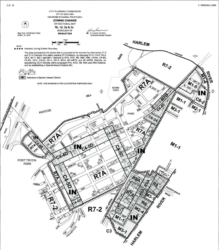
Proposed rezoning. Image credit: CPC.
City expected to appeal Judge’s decision invalidating the Inwood Rezoning. On December 10, 2019, Judge Verna L. Saunders of the New York State Supreme Court, New York county ruled in favor of the Northern Manhattan is Not For Sale’s Article 78 petition challenging the legality of the Inwood Rezoning. The rezoning was proposed by the city’s Economic Development Corporation and was set to up-zone 59 blocks in the Inwood neighborhood of Manhattan. Approval of the rezoning would permit property owners to build mixed-use commercial and residential developments up to thirty stories tall, where predominantly one to two story-buildings and warehouses previously existed. The plan also included nearly 1,600 new affordable housing units. Northern Manhattan is Not For Sale is an unincorporated association of individuals and organizations alleging the City failed to study the critical impacts of the rezoning before City Council approved the application on August 8, 2018. In large part Northern Manhattan is Not For Sale believes that the rezoning will displace longtime Inwood residents.
In finding for Northern Manhattan is Not For Sale, Judge Saunders did not dispute any of the City’s findings during the public review process. Rather, Judge Saunders found that the review process was incomplete and in violation of the State Environmental Quality Review Act.
Under the New York State Environmental Quality Review Act (“SEQRA”), the City Environmental Quality Review (“CEQR”) process occurs in tandem with the ULURP action. The Office of the Deputy Mayor for Housing and Economic Development served as lead agency for the SEQRA/CEQR review, and was thus responsible for coordinating the environmental and socio-economic studies.
In conducting these studies, the City admittedly failed to address the following eight issues raised by the public in both the Draft Environmental Impact Statement (“DEIS”) and subsequently the Final Environmental Impact Statement (“FEIS”):
(1) The impact of the rezoning on preferential rents and on fostering or increased residential displacement;
(2)The racial impact of the rezoning/residential displacement;
(3) The impact of the rezoning on minority and women-owned businesses;
(4) The deviation between predictions of the impact of prior rezoning and actual results;
(5) The social impact of the loss of the community’s library;
(6) The impact caused by the rezoning on emergency response times/response times of first responders;
(7) The cumulative impacts of the rezoning and other major land use events impacting the community;
(8) The speculative purchases of residential buildings in Inwood preceding and coincident to the rezoning.
In making this determination, Judge Saunders cited the 1983 First Department case, Coalition against Lincoln w., Inc. v. New York, stating “[c]ompliance with SEQRA/CEQRA requires agencies to take a “hard look” at environmental consequences and that information be considered which would lend itself to a reasoned conclusion, however, agencies are not required to consider every possible alternative.”
The City argued that they did in fact take a hard look at the relevant areas of environmental concern and properly issued the Statements of Findings under SEQRA/CEQR. The City cited the extensive public review process, modifications, comments, and feedback from the community. Ultimately, the City asserted the FEIS was prepared with the guidance of the CEQR technical manual, satisfying the “hard look” requirement, and relieving them of the obligation to address the eight issues raised by community.
The court thought otherwise. Judge Saunders recognized that a lead agency, in this case the Office of the Deputy Mayor for Housing and Economic Development, is not required to address “every conceivable environmental impact,” but that the point of the public review process is to give the relevant community meaningful involvement. The CEQR manual should therefore be used as a guideline. The manual itself states that the lead agency should “consider public policy and public comments in addition to the technical studies.” The court pointed to this language to reason that the “the public review process should be taken with due regard and the comments derived therefrom should be appropriately considered.” Ultimately, Judge Saunders found that the Office of the Deputy Mayor for Housing and Economic Development did not take a “hard look” at the areas of concern raised by the public, thereby not complying with SEQRA.
The Court annulled the resolution and ordered the Office of the Deputy Mayor for Housing and Economic Development study the eight issues raised by the Community.
The City is expected to appeal the decision. In their official statement, the Law Department stated “We strongly disagree with this ruling which we believe is legally incorrect and contrary to well-established precedent. We stand by the City’s thorough environmental review and will challenge this decision so important projects, including the building of 1,600 new affordable homes in this community, can proceed.”
Howard Goldman, land use attorney and adjunct professor at New York Law School thinks the judgment has the potential to be overturned, as the court might have conflated the issues. He stated “the environmental review is a supplement to the ULURP process…it’s not meant to supersede the process.” Goldman pointed out that “SEQRA is all across the state, yet nowhere else is the ULURP process.”
By: Jason Rogovich (Jason Rogovich is the CityLaw Fellow and New York Law School Graduate, Class of 2019)

